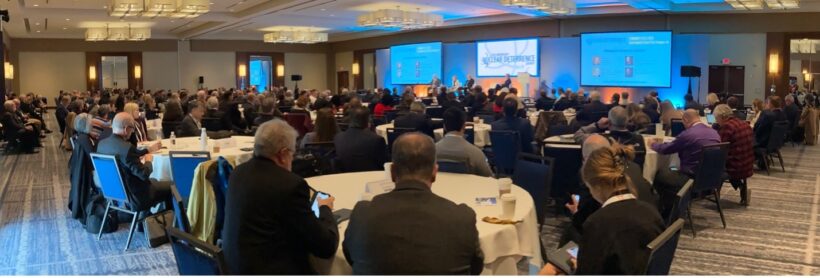What does the nuclear weapons industry talk about when they’re together? I spent three days with 530 government officials, politicians, and corporate contractors in a hotel basement to find out.
The nutshell: They talk about “deterrence” as if there is no alternative. They talk about continually building ever more destructive weapons because they believe that’s what keeps the US and its allies safe from current and future nuclear adversaries. They’re grateful that there is perpetual bipartisan support that keeps them well-funded.
Part I: Articles of Faith
The annual Deterrence Summit, held in February 2023 at the Hyatt Regency Hotel near the Pentagon, was attended by representatives of the federal government, the military, numerous private corporations, the White House, and two members of Congress. I had heard the phrase “Military-Industrial-Congressional Complex,” but I didn’t expect it to be quite so transparent.
The federal Department of Energy (DOE) oversees the semi-autonomous National Nuclear Security Administration (NNSA), which is responsible for building and maintaining nuclear warheads. DOE supplies the warheads to the Department of Defense (DOD), which is responsible for the “triad” of bomb delivery systems: missiles ready to launch from military silos, submarines, and airplanes. Private companies, paid with taxpayer dollars, do nearly all of the science, engineering, and manufacturing at federally-owned warhead laboratories and factories. I listened to the representatives of each sector, and these were 10 themes they all shared:
Theme 1. The nuclear danger to the US and its allies is growing fast, and we must build up our arsenal faster. Summitteers agreed that Russia is “reckless,” with its saber-rattling threats and its misbehavior near nuclear power plants, Iran is enriching uranium, North Korea is expanding its nuclear capabilities – but it’s China we really have to worry about.
There was no mention of how the US may have helped to create these dangers with its own nuclear saber-rattling, NATO expansion, or illegal invasions. Nobody at the Summit asked if these countries were building arsenals to protect themselves from us.
Theme 2. The only way to stay “safe” from nuclear attack is “deterrence.” We must keep “modernizing” the US nuclear stockpile, fast, so the threat of retaliation is so reliable, credible and terrifying that nobody would dare attack.
This “Mission,” as it was reverently referred to, is physically carried out at the 9 sites in 7 states known as the “Nuclear Security Enterprise.” (The NSE has been re-branded from the less Trekkie-friendly name “Nuclear Weapons Complex.”)
“We all agree that the Mission is vital and urgent, and we’re all anxious about how it can be done,” said a panelist. “We’re just keeping the stockpile going. We’re not scaring Russia and China,” said another.
Was I witnessing was the birth of a new arms race?
I write “deterrence” in quotation marks because it is not a universally accepted theory, nor is “threat of use” of nuclear weapons acceptable under international norms. “Deterrence is working in Ukraine,” said one panelist. Maybe — or maybe there are other reasons for Russia not to nuke its next-door neighbor, or its trading partners, or to cause an unthinkable catastrophe.
Alarmingly, the website of US Strategic Command (USSTRATCOM) admits that deterrence can fail. It says that the priority is “to provide Strategic Deterrence,” but “if Deterrence fails, we are prepared to deliver a Decisive Response.”
I had assumed that that such a response would be reciprocal nuclear bombing. But panelist Corey Hinderstein of the NNSA noted: “We don’t have to respond to nuclear with nuclear.” Then why, I wondered, do we have nuclear weapons at all?
“Under declaratory policy,” said another panelist, “we would only use nuclear weapons in extreme circumstances. [Our arsenal has] a unique, irreplaceable deterrent effect [that we will need] for the foreseeable future.”
The Summit attendees seemed comfortable with playing the psychological game of “calculated ambiguity,” or keeping adversaries guessing: will we or won’t we nuke them if they do X, Y, or Z? Nobody talked about what sort of “extreme circumstances” might merit the potential end of human civilization.
Theme 3. Is there life after nukes? This was an extremely minor theme, but I’m including it because it made me hopeful.
Kimberly Budil, director of the Lawrence Livermore National Laboratory, said, “we have capability because of nuclear weapons work. What other challenges can we apply our capabilities to? Climate, environment, WMDs? We can respond to changes in national priorities. We can apply our science and engineering skills to whatever’s important in the nation.”
I also met a contractor who told me, “If there were a way people at this conference could feel good about the security of the country that didn’t require so many nuclear weapons, I would guess almost all of the people would be supportive of that. Certainly there’s a lot of know-how and technology that could be applied with other areas that would be beneficial to the world.”
I remain hopeful that the money, brainpower, and infrastructure might be converted to truly sustainable climate solutions. I hope to conduct more interviews to see how open these people might be to converting the resources, since they know very well that we won’t be truly safe until every nuclear weapon has been dismantled, and we’re working together with our current “adversaries” to keep our species alive.










